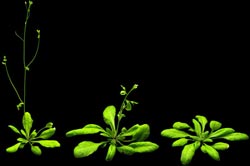A matter of timing

The thale cress, Arabidopsis thaliana, regulates its flowering time in response to temperature. Left: 27 C; centre: 23 C, right: 16 C.<br><br>© MPI for Developmental Biology/Schmid<br>
Too early or too late blooming can have serious consequences for plants: It may reduce the crop of seeds and jeopardize the reproductive success of an entire season. In order not to miss the exact time of flowering, plants have therefore evolved an extensive control system that involves several dozen genes.
Under the leadership of Markus Schmid, molecular geneticist at the Max Planck Institute for Developmental Biology in Tübingen, and in collaboration with the group of Richard Immink, part of Wageningen UR, at Plant Research International in the Netherlands, an international team of researchers has studied two key genes that regulate flowering time in response to ambient temperature. According to their report in the current issue of Nature magazine online, they uncovered a clever molecular mechanism.
Many genes involved in the control of flowering time had already been known from previous studies on the plant Arabidopsis thaliana. “The genetic network integrates the hormonal status as well as external factors such as day length or temperature”, says project leader Schmid. There is still very limited knowledge about the molecular mechanisms by which the ambient temperature influences the flowering decision. The research team therefore focused on two genes, FLM (FLOWERING LOCUS M) and SVP (SHORT VEGETATIVE PHASE), which had already been attributed a key role in this process.
As the researchers were able to show, the FLM gene can give rise to several different protein variants by a process called alternative splicing: After an mRNA copy of the gene has been produced, this pre-mRNA is not directly translated into protein; instead, one or several pieces are cut out – or spliced out as geneticists put it. In genes subject to alternative splicing, this can be done in different ways, producing different mature mRNA-molecules and finally various proteins.
In the case of the Arabidopsis FLM gene there are mainly two splice products, referred to as FLM-β and FLM-δ. A The Tübingen experiments have demonstrated that FLM-activity at low temperatures results mainly in the production of FLM-β. As temperature rises, levels of FLM-β gradually decrease in favour of the expression of FLM-δ. “We observed that this process adapts quite rapidly to temperature changes”, says David Posé, first author of the study. “When heated from 16 °C to 27 °C, the ratio of FLM-variants adjusts within 24 hours.”
Schmid and his colleagues carried out extensive binding studies and found that FLM-β forms a functional protein complex with SVP that can effectively attach to genomic DNA. The binding sites are located mainly within the regulatory regions of genes involved in flowering time and floral patterning. “The SVP-FLM-β complex acts as a potent repressor that prevents the formation of flowers”, explains Prof. Immink, who has specialized in floral induction. The closely related complex consisting of SVP and the “heat indicator” FLM-δ, however, is hardly able to attach to DNA. As a result, the flowering genes are released from repression, become active and promote flower transition.
The international research team is impressed with the elegance and efficiency of this regulatory mechanism. Project leader Schmid analyzes that “instead of tackling the problem with two genes, one of which promotes flowering while the other suppresses it, the plants have combined the two conflicting functions in a single gene.” This results in a dual regulation: With increasing temperatures, the flowering repressor FLM-β is not only produced at a slower rate – it also has to compete for SVP-binding with its own sister-protein, FLM-δ.
Naturally occurring strains of Arabidopsis can differ substantially with respect to their flowering times, and this difference is partly due to the natural variation of the FLM gene. As this variation presumably helps plants cope with differences in growth conditions in different habitats, it could also enable them to adapt to the gradual warming that is expected as a result of global climate change. For Schmid and his colleagues there is no doubt that the newly discovered mechanism will be important, especially for plants that cannot move to cooler habitats. “The role of temperature-dependent alternative splicing in this adaptation process is well worthy of further investigation”, the researchers conclude.
Contact
Prof. Dr. Markus Schmid
Max Planck Institute for Developmental Biology, Tübingen
Phone: +49 7071 601-1411
Email: Markus.Schmid@tuebingen.mpg.de
Nadja Winter
Max Planck Institute for Developmental Biology, Tübingen
Phone: +49 7071 601-444
Fax: +49 7071 601-359
Email: presse-eb@tuebingen.mpg.de
Original publication
David Posé et al.
Temperature-dependent regulation of flowering by antagonistic FLM variants
Nature, 26 September 2013 (doi:10.1038/nature12633)
Media Contact
More Information:
http://www.mpg.de/7530520/flowering-time-arabidopsisAll latest news from the category: Life Sciences and Chemistry
Articles and reports from the Life Sciences and chemistry area deal with applied and basic research into modern biology, chemistry and human medicine.
Valuable information can be found on a range of life sciences fields including bacteriology, biochemistry, bionics, bioinformatics, biophysics, biotechnology, genetics, geobotany, human biology, marine biology, microbiology, molecular biology, cellular biology, zoology, bioinorganic chemistry, microchemistry and environmental chemistry.
Newest articles

Bringing bio-inspired robots to life
Nebraska researcher Eric Markvicka gets NSF CAREER Award to pursue manufacture of novel materials for soft robotics and stretchable electronics. Engineers are increasingly eager to develop robots that mimic the…

Bella moths use poison to attract mates
Scientists are closer to finding out how. Pyrrolizidine alkaloids are as bitter and toxic as they are hard to pronounce. They’re produced by several different types of plants and are…

AI tool creates ‘synthetic’ images of cells
…for enhanced microscopy analysis. Observing individual cells through microscopes can reveal a range of important cell biological phenomena that frequently play a role in human diseases, but the process of…





















